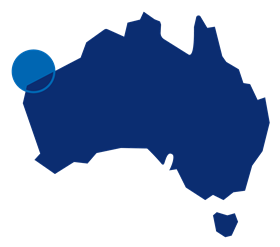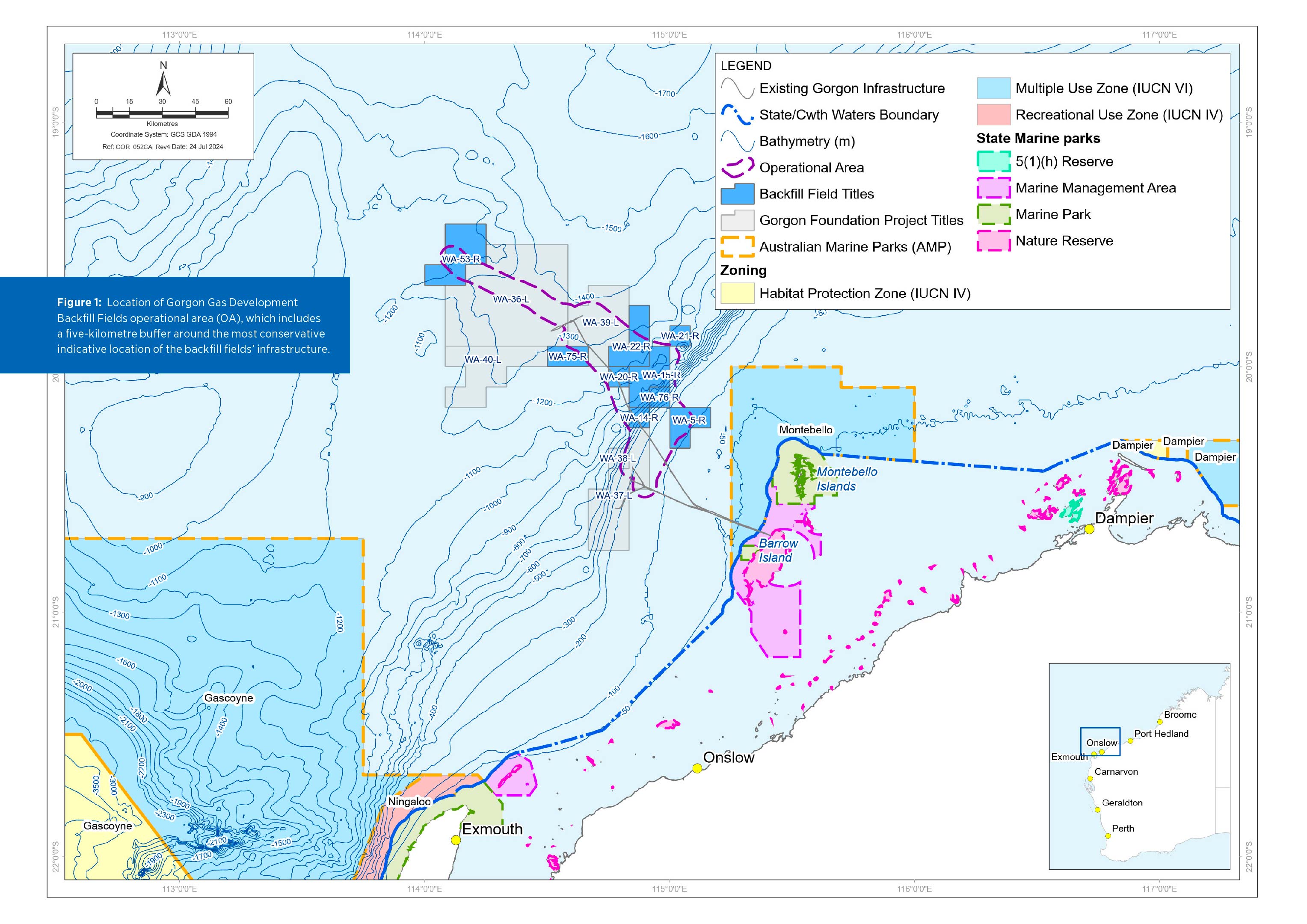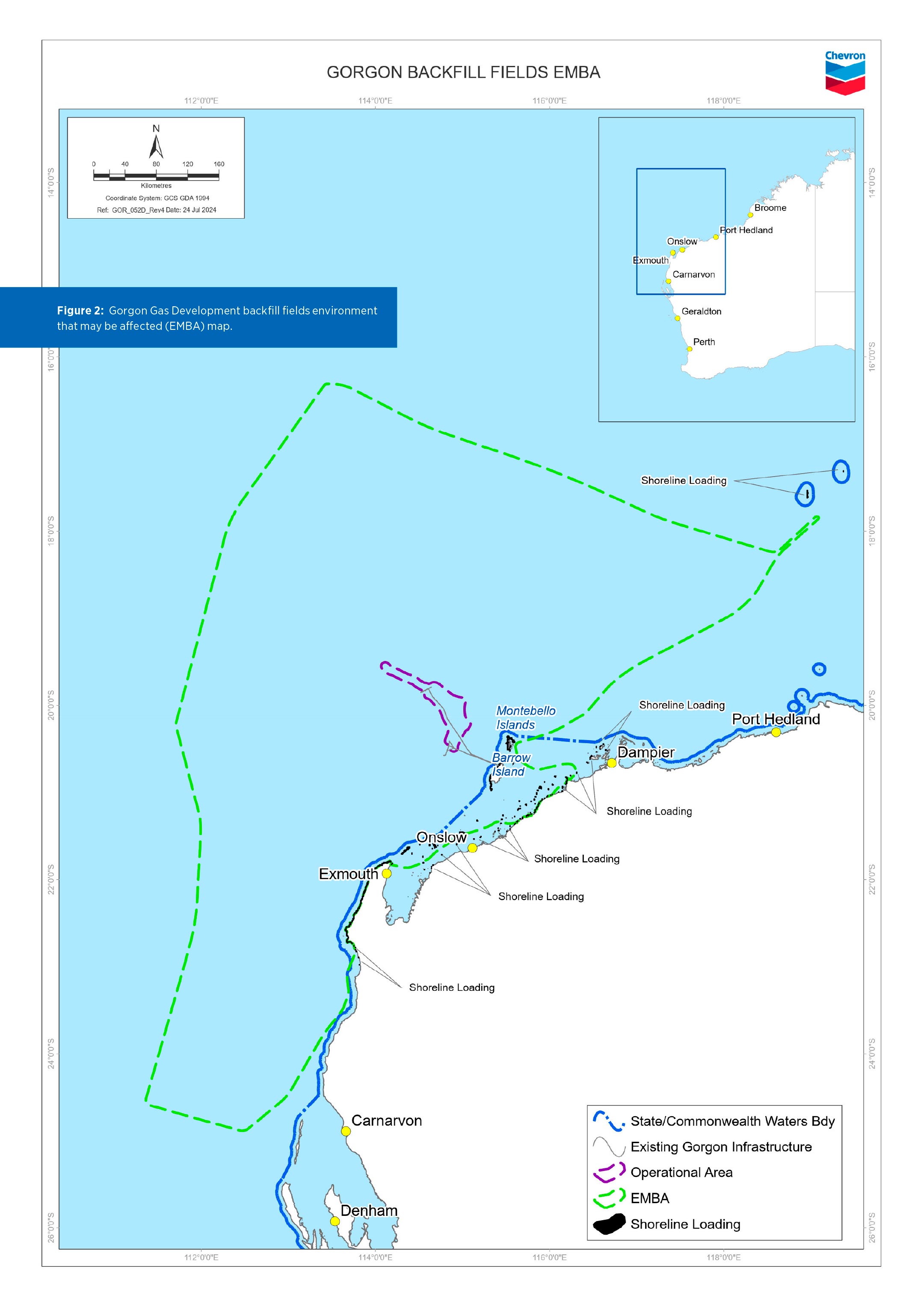activity information
gorgon gas development backfill fields
Chevron Australia, on behalf of the Gorgon Joint Venture, operates the Gorgon Gas Development (Gorgon) located off the northwest coast of Western Australia (WA).
The initial Gorgon approvals process envisaged the development of other ‘backfill’ fields in the Greater Gorgon Area as the Gorgon and Jansz–Io fields depleted over time. A backfill field is a supply of natural gas that is required to maintain the throughput to an operating facility.
The Gorgon Gas Development Backfill Fields (the Development) represents the next phase of Gorgon, and the intent is to maintain current rates of liquefied natural gas (LNG) and domestic gas production at the Gorgon Gas Facility on Barrow Island.
In 2023, we sought initial feedback from stakeholders, including Traditional Owners, to help us prepare an Offshore Project Proposal (OPP) for submission to the National Offshore Petroleum Safety and Environment Management Authority (NOPSEMA).
The Gorgon Gas Development Backfill Fields OPP outlines proposed development activities for the next seven backfill fields: Chandon, Chrysaor, Dionysus, Eurytion, Geryon, Semele and West Tryal Rocks.
NOPSEMA accepted the OPP in October 2025 and has published the final document on its website here.
location and water depth

The seven backfill fields outlined in this OPP are located about 200 kilometres (km) north of Onslow and 100 km north-northeast of Barrow Island. Water depths in the area range from ~150 metres (m) to 1,400 m. Most of the fields are in water depths greater than 800 m. The closest infrastructure to land will be ~60 km from Barrow Island and ~130 km from Onslow. The outermost infrastructure will be ~190 km from Barrow Island and ~250 km from Onslow. Chandon, Chrysaor, Dionysus, Eurytion, Geryon, Semele and West Tryal Rocks are located across titles WA-5-R, WA-14-R, WA-15-R, WA-20-R, WA-21-R, WA-22-R, WA-53-R, WA-75-R and WA-76-R. Figure 1 shows the operational area (OA) in which the petroleum activities described in the OPP will be undertaken, which includes a five-km buffer around the most conservative indicative location of the backfill fields’ infrastructure.
Jump to detailed maps below
schedule and duration
The development of backfill fields will be staggered, so all fields will not be developed in a single campaign.
Subject to relevant approvals, Geryon and Eurytion have been earmarked as the next fields to be developed and are anticipated to be co-developed and use common infrastructure.
Offshore activities for Geryon and Eurytion are proposed to commence from 2026 at the earliest, with operations from 2028 for ~20-25 years.
The subsequent fields will likely be developed post start-up of Geryon and Eurytion, and as each field declines a new field(s) will be developed into the Gorgon and Jansz trunklines. The specific order of development for the remaining backfill fields has not yet been finalised.
The end of field life for the Development is estimated ~2070.
During development periods, work will occur in planned stages and could occur during the day or night.
activity summary
The Development intends to tie the seven backfill fields into existing subsea gathering infrastructure which connects the two currently operational gas fields, Gorgon and Jansz-Io, with the Gorgon Gas Facility. At the Gorgon Gas Facility, gas is processed and liquefied for export as LNG or piped to the mainland for WA domestic gas users.
Planned activities in the fields include:
- conducting geotechnical and geophysical surveys
- drilling wells
- installing a subsea gathering network that connects the wells to the existing Gorgon and Jansz-Io pipelines
- commissioning and start-up
- operating infrastructure, including inspection, maintenance and repair
- operating vessels, helicopters and remotely operated vehicles
- decommissioning.
Subsea infrastructure will include:
- wells and associated infrastructure
- flowlines carrying gas from the fields to the Gorgon and Jansz-Io pipeline tie-in locations
- umbilicals to convey electricity, fibre-optic cables, and hydraulic and other fluids.
No permanent structures will be above the sea surface.
approvals process
The Gorgon Gas Development primary approval granted under the Environmental Protection and Biodiversity Conservation Act 1999 (Cth) and Environmental Protection Act 1986 (WA) included development of the Gorgon and Jansz-Io fields and construction of the Gorgon Gas Facility on Barrow Island. These approvals envisaged the subsequent development of backfill fields within the Greater Gorgon Area.
The backfill fields will not increase the life or capacity of the Gorgon Gas Facility beyond the approved Gorgon Gas Development.
The OPP includes:
- an assessment of environmental impacts and risks to show that the activities are environmentally acceptable
- identification and assessment of feasible alternatives including a comparison of environmental impacts and risks
- clearly defined and measurable environmental performance outcomes, and
- sufficient information to allow the public to provide informed comment.
After submission, NOPSEMA first checks that there is enough information for members of the public to make an informed comment.
NOPSEMA then sets a public consultation period, during which stakeholders can submit comments. After comments have been received and addressed, NOPSEMA begins their assessment to decide whether to accept or reject the OPP.
NOPSEMA’s acceptance of the OPP is a general indication of the Development’s environmental acceptability, however, it does not allow Chevron Australia to commence work.
Before commencing work on any part of the Development, we will prepare a more detailed environment plan (EP) for each petroleum activity for review and acceptance by NOPSEMA. During the preparation of the EPs, we will conduct further and more detailed consultation with relevant persons to inform the control measures adopted for each activity.
As each backfill development under the OPP moves towards production, they will be subject to life-of-field Petroleum Production Licence and Pipeline Licence applications, as required.
EMBA – environment that may be affected
As part of our environmental assessment and consultation process, we create an EMBA map to provide geographical context for stakeholders to determine if their functions, interests or activities may be affected by an offshore activity during operations or in an emergency scenario.
Figure 1 shows the OA and the EMBA. The EMBA has been defined through combining 300 simulations from a loss of well control scenario from each of the seven fields under different weather and ocean conditions. This means that in the highly unlikely event an unplanned release does occur, a geographical area much smaller than the EMBA would be affected. Shoreline loading refers to areas of the coast that may be impacted by hydrocarbons.
Chevron Australia has systematic control measures to prevent and mitigate emergencies and to reduce the impact of planned activities on the environment, including ecological, social and cultural values and sensitivities.
Table 1 summarises the key impacts and risks and proposed controls identified at this stage to manage these to levels that are acceptable. Additional control measures may be identified during the consultation process and preparation of EPs for each petroleum activity.
your feedback
NOPSEMA’s public comment period for the Gorgon Gas Development Backfill Fields OPP was open from 9 August - 1 November 2024.
During this time, community members and stakeholders were able to review the OPP and provide feedback to NOPSEMA on environmental management matters related to our activities.
Chevron Australia will now prepare and submit a Consultation Report to NOPSEMA, which includes a statement of response to each comment received and a description of any changes made to the OPP as a result. NOPSEMA will then begin the assessment process.
If the OPP meets the criteria set out in the Environment Regulations and the OPP is accepted, NOPSEMA will publish the final OPP in full on its website here.
For more information on our proposed activities, you can contact us toll free on 1800 225 195 or via the feedback form below.
privacy notice
If you choose to provide feedback, Chevron Australia will collect your name and contact details, for the purposes of maintaining contact with you and including your feedback in our submission to NOPSEMA. Provision of this information is purely voluntary, however if you choose not to provide it, we may not be able to contact you in the future. Chevron may transfer your information to NOPSEMA if required and, if you do not identify it as sensitive, to other Chevron affiliates including our head office in the United States.
For further information regarding how we protect your personal information, and your rights, please refer to our privacy notice.
further information

Figure 1. Location of Gorgon Gas Development Backfill Fields operational area (OA), which includes a five-kilometre buffer around the most conservative indicative location of the backfill fields’ infrastructure.

Figure 2. Gorgon Gas Development backfill fields environment that may be affected (EMBA) map.
Table 1: Summary of key impacts/risks and key proposed control measures for proposed activities – view here.
resources
- Public comments on Offshore Project Proposals – NOPSEMA opens in new window
- Environmental requirements – NOPSEMA opens in new window
- Offshore Petroleum and Greenhouse Gas Storage (Environment) Regulations opens in new window
- Chevron Operational Excellence Management System (OEMS) opens in new window
- gorgon gas development backfill fields information sheet pdf opens in new window
